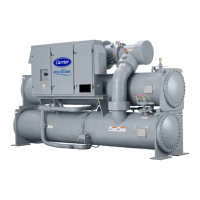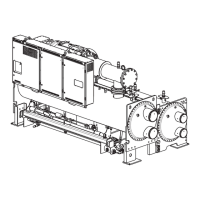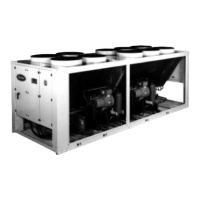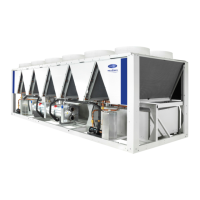12
Slide Valve Principle —
Oil flow to the slide piston is
controlled by two solenoid valves. Each solenoid is operated
by load and unload signals from the PIC II control.
To unload the compressor, the unload solenoid valve is en-
ergized and the load solenoid valve is deenergized. This con-
ducts high pressure oil to the cylinder, retracting the capacity
rod, and modulating the slide valve toward the open position.
See Fig. 6. The slide valve opening vents compressed gas back
to the suction port on the compressor, retarding the start of the
compression process.
To load the compressor, the unload solenoid valve is deener-
gized and the load solenoid valve is energized. This bleeds oil
from the cylinder to the suction pressure area within the com-
pressor housing. Forces resulting from the discharge-to-suction
pressure differential are then allowed to push the slide valve to-
ward the closed (fully loaded) position. See Fig. 7. When the
slide valve is closed, the compressor pumps the maximum gas
flow.
Extension and retraction of the piston/capacity rod position
the slide valve along the bottom of the rotors. The valve posi-
tion controls the gas flow rate delivered by the compressor.
STARTING EQUIPMENT
The 23XL requires a motor starter to operate the centrifugal
hermetic compressor motor and various auxiliary equipment.
The starter is the main field wiring interface for the contractor.
See Carrier Specification Z-415 for specific starter require-
ments. All starters must meet these specifications in order to
properly start and satisfy mechanical safety requirements.
Starters may be supplied as separate, free-standing units or may
be mounted directly on the chiller (unit mounted) for low-volt-
age units only.
Multiple separate circuit breakers are inside the starter. Cir-
cuit breaker CB1 is the compressor motor circuit breaker. The
disconnect switch on the starter front cover is connected to this
breaker. Circuit breaker CB1 supplies power to the compressor
motor.
Circuit breaker CB2 supplies power to the control panel, TC
frame 1 and 2 chillers, oil heater, and portions of the starter
controls.
An optional circuit breaker is available when required for a
pumpout unit.
All starters must include a Carrier control module called the
Integrated Starter Module (ISM), excluding the Benshaw solid-
state starters. This module controls and monitors all aspects of
the starter. See the Controls section on page 14 for additional
ISM information. All starter replacement parts are supplied by
the starter manufacturer excluding the ISM (contact Carrier’s
Replacement Component Division [RCD]).
The main circuit breaker (CB1) on the front of the starter
disconnects the main motor current only. Power is still
energized for the other circuits. Two more circuit breakers
inside the starter must be turned off to disconnect power to
the PIC II controls, and TC frame 1 and 2 chillers oil
heater.
Pumpout compressor voltage must be the same as the com-
pressor motor voltage.
Fig. 5 — Screw Compressor Principle
HIGH
PRESSURE
OIL
ROTOR
UNLOAD
SOLENOID
VALVE
LOAD
SOLENOID
VALVE
PISTON
TO SUCTION PORT
SLIDE VALVE
Fig. 6 — Slide Valve Position at Unload
Fig. 7 — Slide Valve Position at Full Load

